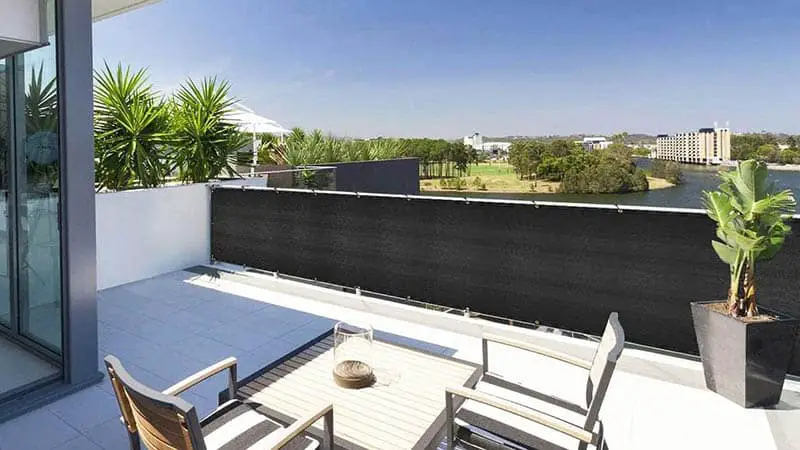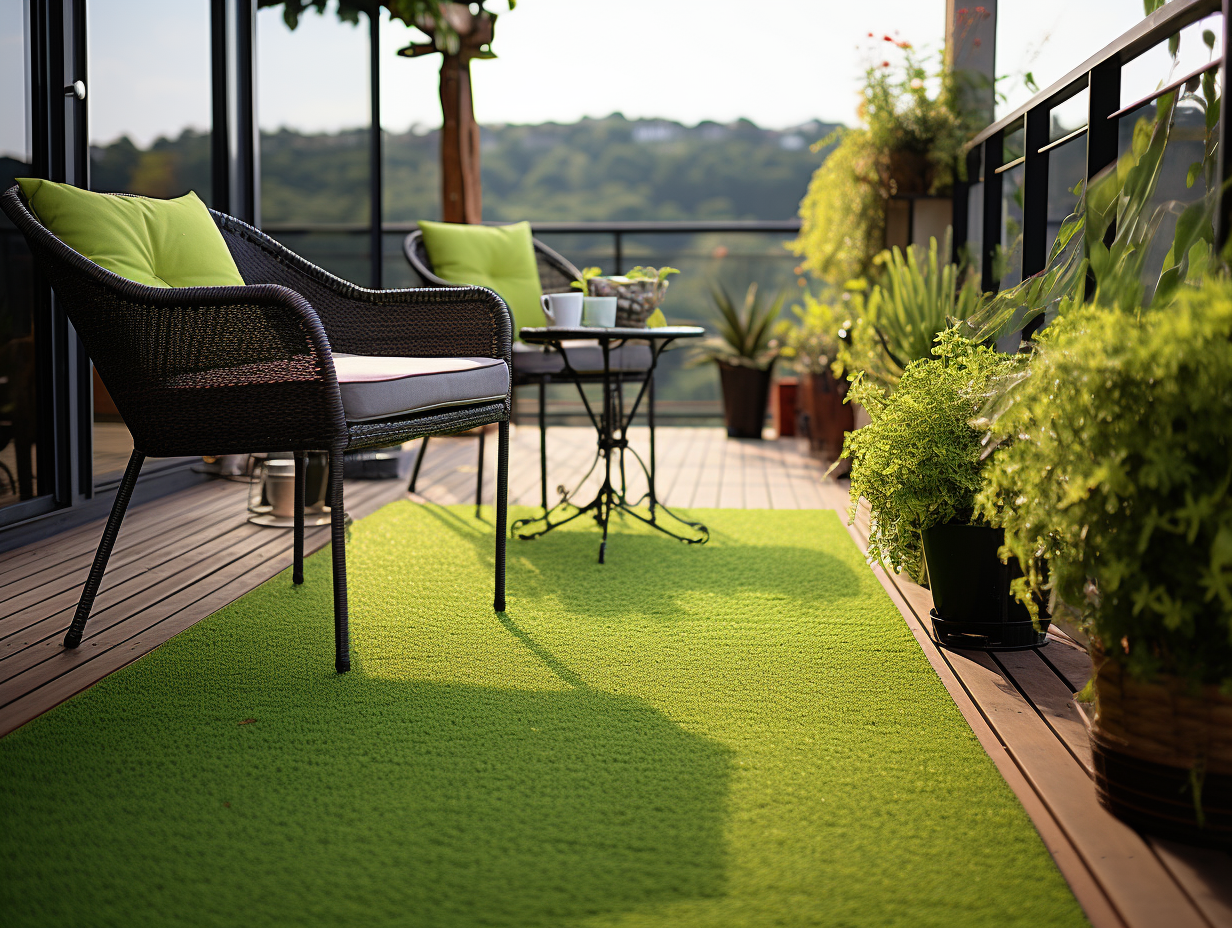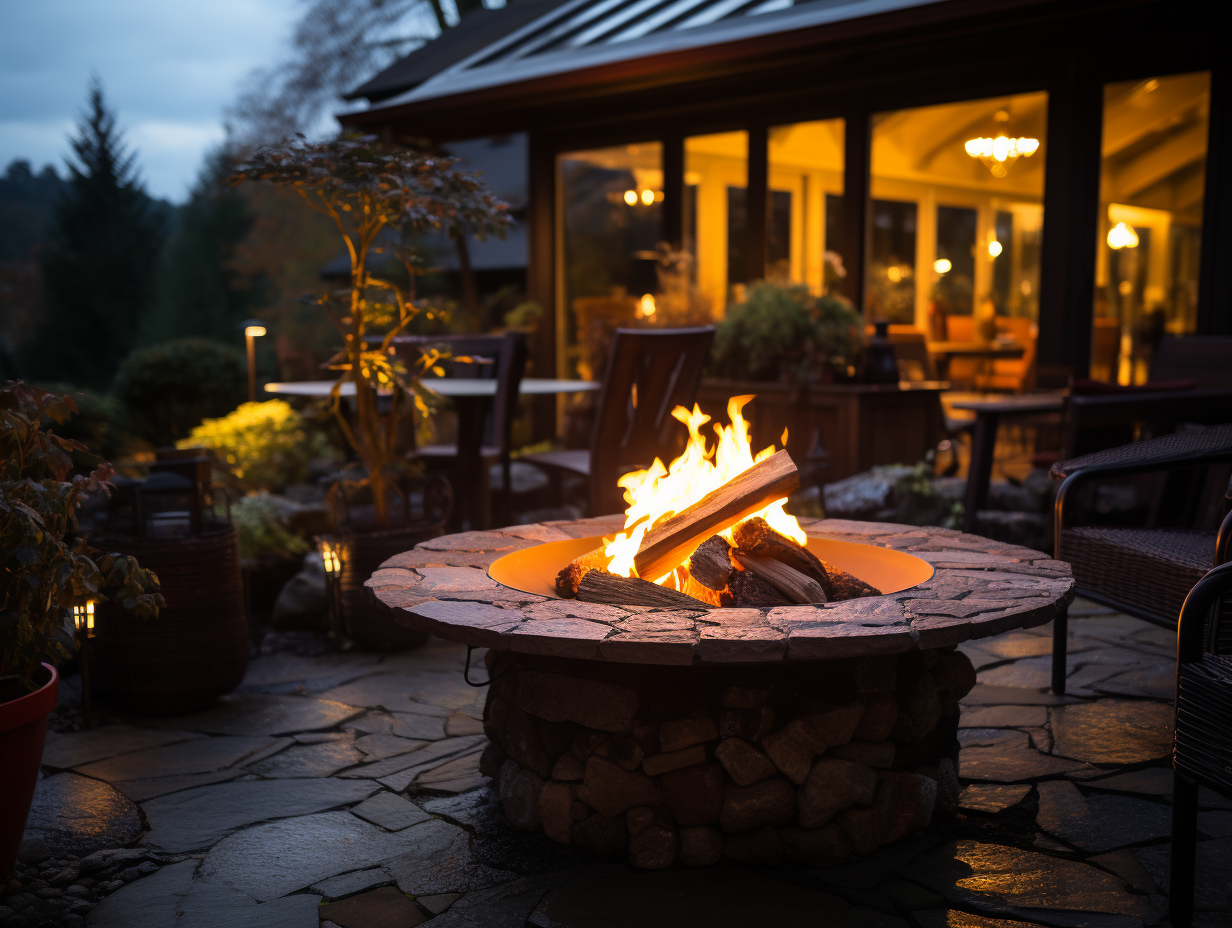What’s the best way to enjoy a patio on a windy day? The answer is simple: block the wind.
Trying to enjoy your patio on a windy day can be difficult, but not if you take the time to plan ahead. Patios are great for entertaining during the summer months, so it’s important to have some wind blockers in place.
I will walk you through 9 easy ways to block the wind from your outdoor space.

How to Block Wind on Patio DIY
Wind can be a significant nuisance on patios, particularly if you live in an area with particularly windy conditions.
The good news is that there are a number of simple and affordable methods for keeping the wind from ruining your patio experience without ruining your view or blowing your budget.
Before we start, we should note that the most effective way to block wind will depend largely on the layout and architecture of both your home and the patio itself.
1. Install A Wind Screen
Deck fence screens are a popular solution for windy patio problems. It is, as the name implies, a fence made of a very strong and durable net material that can be attached to wooden or metal panels.
The fence can be built around the patio area to keep winds at bay and prevent them from interfering with normal activity and enjoyment on the patio. Fence screens are typically made of high-quality, long-lasting materials that are also water-resistant.
They are also highly resistant to fading, which allows the fence to last longer even in hot, sunny weather or heavy rains.
Despite its typical forms and characteristics, a few of them may have particular characteristics and properties that allow them to endure a variety of weather conditions while also resisting powerful winds.
They are generally about 3 feet tall, and they work well as a shading solution as well. Some businesses may provide you with creative opportunities to modify designs based on your specific context and needs.
My favorite option is the Tang Privacy Fence Screen. You have a choice of 9 different colors, as well as some options with stripes.
Having the ability to select colors makes styling your patio a breeze. This fence screen provides privacy while also effectively blocking wind. Amazon has hundreds of dimensions to choose from.
2. Artificial Hedge Walls
The thing about artificial hedge walls is that they appear more like decorative pieces than functional products, which is obviously a good thing!
These hedge walls are a wall of artificial foliage that is erected to serve as a barrier but also serves as decoration. They are made of high-quality, long-lasting materials, especially those designed for long-term outdoor use.
Most of the time, the foliage or greenery used is eco-friendly, easy to maintain, and does not cause any inconvenience. The greenery completely covers the supporting frame. The frame is then secured to a fence or wall that surrounds the patio.
The AGPL Artificial Hedge Wall is a great decorative piece to put on a patio to keep the wind at bay.
3. Wooden Fences
Woodblock fences are attractive options for the outdoors, regardless of why you want to install one. Nonetheless, they are excellent at keeping the wind out and providing a lot of privacy.
There are numerous options available, as you can select the type of wood as well as the style of your fence. You may prefer horizontal bars with a glossy appearance or vertical bars with a lovely, matte finish.
Whatever option you choose, keep in mind the main purpose or requirement, which is to reduce the amount of wind that blows into your patio. When considering this specific purpose, you may need to narrow your options and consider what the most suitable and practical option is.
4. Glass Walls
Glass walls surrounding patios are becoming more common. The best thing about them is that they work well both as a windbreak and as a stylish, decorative option for the outdoors.
Glass walls and doors frequently add elegance and a touch of luxury to outdoor spaces. They are typically made of thick, strong, and firm glass panels attached to a strong metal frame that is drilled into the patio’s floor and possibly the walls. It can be a full glass wall or just a section of the deck with a glass railing.
Maintenance is simple, as you can clean the panels with water and soap or simply with window cleaners.
One of the best things about glass walls is that they completely keep the wind out while still allowing plenty of light and allowing you to enjoy the beautiful views from your patio.
Modern glass walls frequently come in a variety of styles and features, such as sliding or adjustable walls.
5. Privacy Screens
Because of their convenience, these reversible privacy screens are useful. When compared to most other options, this is more temporary and usually does not require a complex process to set up or takedown.
These freestanding screens are frequently available in wooden designs to suit any outdoor setting and are also quite stylish.
The hinged panels can be arranged as desired to increase concealment and, of course, wind protection. They are made of heavy-duty materials and are extremely durable, whether they are made of wood or resin.
They are also resistant to weather and fading. As a result, you won’t have to worry about it being a temporary solution because it will last as long as it is required.
These screens are also useful for concealment if you want to keep any mess in the area out of sight of the public.
These Freestanding Outdoor Panels are a well-liked item for protecting your patio against the wind.
I think it works well against the wind, but what I like best about it is that you can use it whenever you need to.
The wall is simple to erect and demolish. Simply stand it up and fold it into the shape you want.
Use rope, zip ties, or something to keep them upright in the wind. When used on the lawn, the included pegs can be hammered into the ground for added sturdiness.
6. Potted Scrubs
Many people choose wind-blocking methods such as arranging plants and shrubs in their patios and balconies to help reduce wind.
Some of these methods, particularly lining potted plants around patio or balcony areas, have proven to be effective. So far, planting trees and shrubs in concrete pots appears to be the most effective method.
For starters, concrete pots are strong and can withstand high winds. Second, concrete pots are thought to be better for plants.
You can also make a DIY wooden planter that is bracketed to the patio floor. This would keep the plant from toppling over, making it ideal for a windy patio.
After conducting some research on the best types of plants for this purpose, I discovered that Bamboo, Frangula, and Houseleeks (Hens and Chicks) are effective in controlling winds due to their diverse properties and physical structures.
For effective protection, you may also want to ensure that you find plants of the desired height rather than those that are too short. Set them up close together so that they can effectively keep the wind out.
7. Windscreen Fence
If you want proper, all-around coverage around your patio, you should look into windscreens for fences. These are fantastic solutions for both residential and commercial settings.
These are excellent for privacy and blocking in your yard, poolside, patio, or on a large construction site. You could have a fence all around a low patio, which is usually in your backyard where you have extra land.
Using a fence windscreen provides privacy and significantly reduces the amount of wind that flows around your home.
I Found Some Great Ones HERE
They are typically 6-8 feet tall. Some may also be customizable based on your needs. Outdoor windscreens are frequently made of a strong knitted design and a strong material such as polyethylene.
They should be available in standard, solid colors such as black or dark brown.
There’s no need to be concerned about how well these will last because they’re usually of high quality and resistant to UV and water, making them extremely durable and long-lasting. It’s not difficult to set them up if you can get the good stuff from the right places.
8. Install Outdoor Shades
If you haven’t already considered it, outdoor shades are an excellent solution to the winds that keep blowing everything off your patio. While shades are commonly used to keep out sunlight and heat, they also appear to work well in terms of wind protection.
They may be available in a dropdown style, a roller style, and a few other variations. They are made of a strong, long-lasting fabric that is UV and water-resistant. When it comes to outdoor shades, upkeep is simple.
They are also convenient because they can be removed and replaced as needed, with some styles being easier to do than others. When the winds seem to be more than just a breeze, these could be a great option.
9. Outdoor Furniture
Choosing specific types of patio furniture may make a difference, even if it does not sound convincing. For good reason, many people prefer heavy furniture, such as outdoor sectional sofas.
When you consider sectionals, they are similar to a single mass of furniture with a significant amount of weight. Such items will take up a significant amount of space on your patio, which means they will be able to block out some, if not the majority, of the wind that blows in.
This is why it is preferable to choose heavy, ‘chunky’ furniture over those with small and light, individual pieces. Keep this in mind, especially if the dreaded winds and gusts are more of a concern than having stylish furniture.
10. Climbing Vines On Trellises
Install trellises on your patio and train climbing vines to grow on them. This will also be an excellent way to add shade and beauty to your patios.
Climbing vines are visually appealing and can block both wind and sunlight in your outdoor spaces. Trellises not only provide support for climbing vines and shrubs but also serve as a decorative element in the garden.
| Windbreak | Pros | Cons |
| Living Screens – Shrubs | Cost-effective, beautiful, natural | Ineffective against high winds, moderate upkeep |
| Living Screens – Trees | Cost-effective, beautiful, natural, highly effective long-term solution | Long time to establish, high upkeep in fall |
| Trellises | Easy to install, decorative, no upkeep | Only adequate against light winds, expensive |
| Bamboo Screens | Effective solution, very versatile | Moderately expensive, difficult to install |
Climbing rose, clematis, passionflower, grapes, trumpet vines, and bougainvillea are just a few of the fast-growing vines you can train on your trellises. The majority of these vines will bloom and add to the beauty of your outdoor space.
What Can I Use To Block Wind On My Porch?
If you want to naturally block the wind from your porch, you may use trees or shrubs to form a windbreak. Small trees and vertical bushes can be planted directly against the porch’s side, while large trees may be planted 15 to 20 feet away and still offer wind protection.
Planting trees or bushes along one or more sides of the porch will create a windbreak to protect you from gusty winds. If planting several trees, spacing them about 5 feet apart should provide ample room for growth and offer enough protection after 10 or 20 years.
Shrubs spaced 4 feet apart will also work well in creating the windbreak.
If there is not enough space on your property to plant additional shrubbery, consider using lattice panels instead.
Attach paneling made of 1-by-2 inch boards horizontally across the front of your porch without fastening into place until fall when all danger of hard freezes has passed. By then the lattice panels should be sturdy enough to support climbing vines such as English ivy.
Once the lattice panels are secure, start training ivy vines or other climbing plants to grow up and over them by fastening the stems of the plant in place every 6 inches with twist ties.
Continue to train several vines along with each panel of lattice until they have filled it completely. An added benefit of this natural windbreak is that it will also provide an extra measure of privacy.
How Do I Block Wind Without Blocking?
Plants and trees are a fantastic way to utilize a natural windbreak. A lovely hedge is created by plantings around the patio. They should be trimmed at about three to four feet tall, since they may block the view but also protect the patio from strong winds. Hedges provide a timeless touch to the space.
If you have a garden, try to surround the patio with trees and plants. They will provide a natural wind block, but also offer shade from direct sunlight or provide a good background for socializing.
A pergola is a great addition where it lets in light but protects from strong winds as well as provides some shade during the hot season.
Shade-loving vines such as jasmine can be grown on top of the structure; they may climb all around it and create an amazing look by late summer.
You may also choose more flowering creepers that grow up walls like wisteria or Carolina Jessamine (Gelsemium sempervirens). If you want your pergola to be visible at night, consider planting Phlox subulata or Virginia Bluebells (Mertensia virginica) below.
They are cold-hardy perennials that flower in spring and will create beautiful floral carpets by late summer.
Do Screens Block Wind?
Yes, Screens block wind a screen can also be used to create a wind break, but only in the open air. In confined spaces, though, such as stairwells and hallways of buildings, strong winds might become obstructed by the density of the screen.
The force driving those winds is absorbed by the screen, causing the wind stream to veer off in different directions. Rain that comes into contact with the screen is split into smaller droplets owing to its high density.
Conclusion
The patio is a great place to relax and spend time with friends, but if you’re not careful, the wind can make it unbearable.
Hope our list on how to block the wind on your patio helped you.

![What Gravel To Use For Patio Base [Best Options]](https://www.cleverpatio.com/wp-content/uploads/2021/11/What-Gravel-To-Use-For-Patio-Base-270x180.jpg)



Leave a Reply